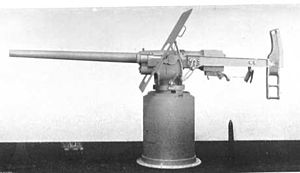
Back QF 6 pounder Hotchkiss Czech Ordnance QF-6-Pfünder Hotchkiss German Hotchkiss QF de 6 libras Spanish QF 6 naulan Hotchkiss Finnish Canon de 57 mm Hotchkiss French Hotchkiss 57 mm Italian 57-мм пушка Гочкисса Russian QF 6-pounder Hotchkiss Turkish 57-мм гармата QF 6-pounder Hotchkiss Ukrainian
| QF 6 pounder Hotchkiss | |
|---|---|
 Early Elswick gun on recoil mounting | |
| Type | |
| Place of origin | France |
| Service history | |
| In service | 1885–1990 |
| Used by | See Users |
| Wars | See Wars |
| Production history | |
| Designer | Hotchkiss et Cie |
| Designed | 1883 |
| Manufacturer | Elswick |
| Produced | 1884 |
| No. built | 3,984 (UK) |
| Variants | 40 to 58 calibre |
| Specifications | |
| Mass | 821–849 lb (372–385 kg) barrel & breech[1] |
| Length | 8.1 ft (2.5 m) |
| Barrel length | 7.4 ft (2.3 m) 40 calibre |
| Shell | 57x307R; see ammunition section |
| Calibre | 57-millimetre (2.244 in) |
| Breech | Vertical sliding-block |
| Recoil | Hydro-spring, 4 inch |
| Elevation | Dependent on mount |
| Rate of fire | 25 / minute[2] |
| Muzzle velocity | 1,818 feet per second (554 m/s)[3] |
| Effective firing range | 4,000 yards (3,700 m)[4] |
The Ordnance QF Hotchkiss 6 pounder gun Mk I and Mk II or QF 6 pounder 8 cwt were a family of long-lived light 57 mm naval guns introduced in 1885 to defend against new, small and fast vessels such as torpedo boats and later submarines. Many variants were produced, often under license, which ranged in length from 40 to 58 calibres, with 40 calibre the most common.
6-pounders were widely used by the navies of a number of nations and often used by both sides in a conflict. Due to advances in torpedo delivery and performance, 6-pounder guns were rapidly made obsolete and were replaced with larger guns aboard most larger warships. This led to their being used ashore during World War I as coastal defence guns, the first tank guns and as anti-aircraft guns, whether on improvised or specialized HA/LA mounts. During World War II 6-pounder guns were put back in service to arm small warships and as coastal defence guns. The last ships to carry 6-pounders were the Aegir-class offshore patrol vessels of the Icelandic Coast Guard[citation needed] which replaced them in 1990 with the Bofors 40mm L/60 autocannon.
- ^ Hogg & Thurston 1972 quote 821 lb (372 kg) for the UK 40-calibres coast defence gun. DiGiulian quotes 849 lb (385 kg) for the naval gun. Weights varied according to barrel length.
- ^ 25 rounds per minute is the figure given by Elswick Ordnance for their 40-calibres model. Quoted in Brassey's Naval Annual 1901
- ^ 1818 ft/s in British service, with 90-inch (2.3 m) bore, using propellant of 1 lb 15 oz (0.88 kg) Q.F. black powder or 7¾ oz cordite size 5. Text Book of Gunnery, 1902, Table XII, Page 337.
- ^ Hogg&Thurston 1972, Page 36–39 quote 7,500 yards (6,900 m) maximum for the British version. Text Book of Gunnery 1902 quotes 4,000 yards (3,700 m).